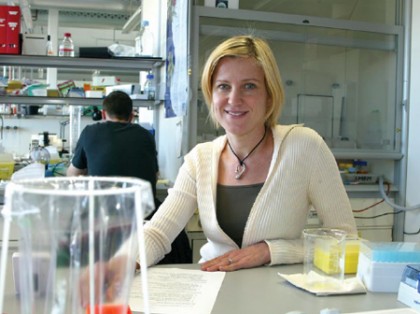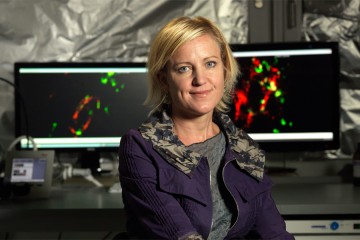The following article was published in the Winter 2007 issue of Johns Hopkins Engineering magazine

Melody Swartz '91 swims against the current, a characteristic that has led her around the world, prompted her groundbreaking research, and landed her on Popular Science's "Brilliant 10" list for 2006.
Now in its fifth year, the list is garnered from recommendations made by respected scientists, journal editors, and university department heads from around the country. It's aimed, notes Popular Science, at recognizing "the mavericks. The young guns. The individuals who are changing not just what we know but the limits of what we think it's possible to know."
Swartz, currently an associate professor with the Institute of Bioengineering at the École Polytechnique Fédérale de Lausanne (EPFL) in Switzerland, was recognized for her groundbreaking research on the relationship cells have with their physical environments. By focusing on how such environmental factors affect tissue development and remodeling, she aims to better understand tissue regeneration in disease processes—knowledge that can be applied toward improved tissue engineering.
Scientists have known for quite some time how to engineer simple tissue types, such as skin and heart muscle. But when they tried to engineer more complex types of tissue, they met with failure. As it turns out, capillaries present an enormous challenge. They are essential to tissue engineering, but researchers have found them notoriously difficult to create outside the body. The more complex the type of tissue, the less successful scientists were. Enter Melody Swartz.
"It's not that complicated after all," says Swartz. "Cells just need to be exposed to the right physical forces." And by that she means the current of the intercellular fluid that flows through our tissues.
Last fall, she published a paper in Proceedings of the National Academy of Sciences that outlined her discovery that super-slow currents flow between cells and redistribute proteins, a process that then triggers cells to organize into capillary networks. Without these slow currents, the capillaries will not form correctly.
Swartz's finding could hold the long-soughtafter key to growing tissue and organs in the lab, according to Popular Science. "She was the first to show that these slow streams are so crucial to development that when they are absent, specialized tissues degenerate into something of a biological casserole gone wrong," noted writer Elizabeth Svoboda, whose article also quoted Massachusetts Institute of Technology bioengineer Linda Griffith. "[Swartz is] showing how sensitive cells are to small changes in flow," said Griffith. "These are phenomena that will endure as foundational ideas."
Swartz says her approach to science has always been driven by her mechanical mind— which prompted her decision to pursue engineering as an undergraduate at the Whiting School. "I did research throughout my four years as an undergraduate at Hopkins and really appreciated the size of our chemical engineering department, the attention we were given by the faculty, and the fact that we were like a tight-knit family—all the undergraduates, graduate students, post-docs, and faculty in Chemical Engineering knew each other," Swartz says. "I had a great experience."
After earning her BS in chemical engineering in 1991, Swartz decided to switch gears and pursue environmental engineering. She boarded a plane bound for a chain of islands in the Pacific Ocean and spent the next year working for the Federated States of Micronesia, at the Pohnpei and Yap State Environmental Protection Agency.
Swartz returned to the United States and spent another year as a research assistant at Northwestern University before completing her PhD in chemical engineering at MIT. After a post-doc year at MIT, she returned to Northwestern as an assistant professor in the departments of Biomedical Engineering and Chemical Engineering. She continues to hold an appointment there today and serves on the research faculty at the EPFL's Institute of Bioengineering where she uses her engineering background to focus her research on tissue engineering and cell mechanics. "We explore these concepts on the basic level," she says, "to understand tissue generation in disease processes and apply them to tissue engineering," with implications as diverse as drug development and cancer research.
Posted in Health, Science+Technology
Tagged bioengineering, melody swartz








